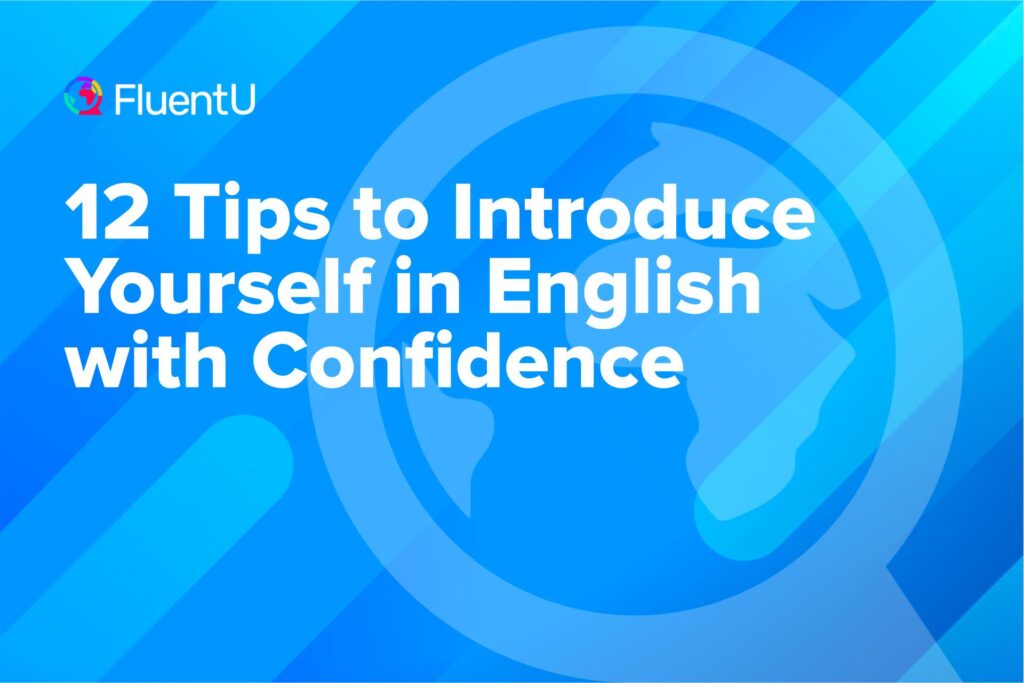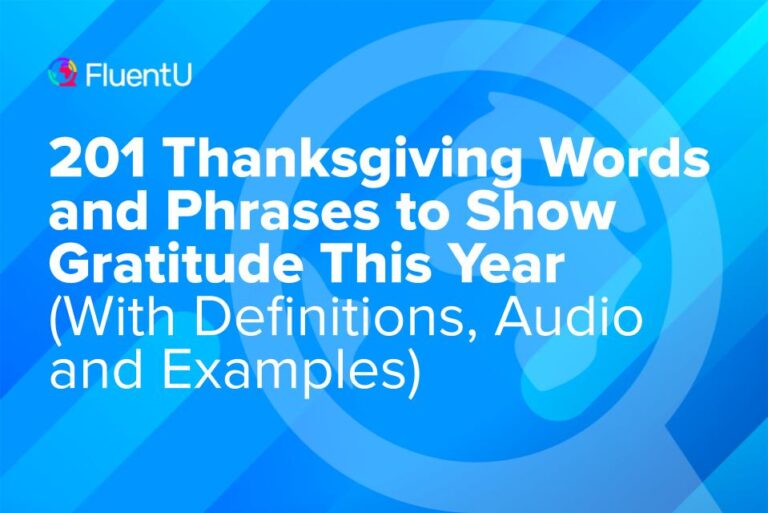Contents
- 1. Say “Hello,” followed by your name
- 2. Say “Nice to meet you, [the other person’s name]”
- 3. Use common greetings depending on the time of day
- 4. Provide basic information about yourself
- 5. Talk about the things that make you unique
- 6. Ask basic questions about the other person
- 7. Compliment the other person
- 8. Give positive, concise answers to someone’s questions
- 9. Ask lots of follow-up questions
- 10. Prepare to end the conversation
- 11. Don’t forget to use your body language
- 12. Practice, practice, practice
- And One More Thing...
12 Tips to Introduce Yourself in English with Confidence

One of the very first English lessons you learn is how to introduce yourself. But how do these lessons stack up (compare) against what happens in the real world?
Below, I’m going to go over all the English phrases you need to meet someone new. We’ll talk about how to introduce yourself in English in both informal and formal situations—even if you’re a complete beginner.
Download: This blog post is available as a convenient and portable PDF that you can take anywhere. Click here to get a copy. (Download)
1. Say “Hello,” followed by your name
The easiest way to break the ice (start a conversation) is to just say “Hello, I’m [your name].”
Amy: Hello! I’m Amy.
The other person will say:
Brian: Hi there! I’m Brian.
2. Say “Nice to meet you, [the other person’s name]”
If the other person initiates (starts) the conversation, use this phrase to answer them.
3. Use common greetings depending on the time of day
You can also break the ice with time-dependent greetings like:
- Good morning. If your clock says “a.m.,” use this greeting.
- Good afternoon. Use this greeting from 12:00 p.m. to when the sun goes down. This is usually around 5 to 6 p.m.
- Good evening. If it’s already dark outside and it’s not yet 12:00 a.m., use this greeting.
Here are other English greetings you can use based on how formal the situation is.
4. Provide basic information about yourself
To introduce yourself in English, give a little bit of information about yourself.
For example, in an informal context, saying where you’re from is a good conversation starter.
In a formal context, like a job interview or meeting new co-workers, you want to have an elevator pitch . The reason it’s called an “elevator pitch” is because it answers this question: if you only have one elevator ride (or 30 seconds) to introduce yourself to a business associate, what would you say?
Let’s have a look at sample elevator pitches from our two friends, Amy and Brian:
Amy: I work for an IT company in Lower Manhattan.
Brian: I’ve been working as a freelance translator since 2002.
They can also say something like:
Amy: I’ve been working as an editor for Select Magazine for 15 years.
Brian: During the last 10 years, I’ve been in charge of managing translation projects related to marketing.
See? These statements may be short and to the point, but they’re impactful because they go into the important details right off the bat (immediately). If you have any impressive qualifications (like Amy’s 15 years of experience with Select Magazine), introduce yourself with those.
5. Talk about the things that make you unique
Once you’ve gotten the basics out of the way, you can go into a little more detail. You want to answer the question, “What makes you different?”
In an informal context, you can talk about your interests:
When I’m not working, I like to go hiking.
In a formal context, you can summarize your skills, experiences and other things that make you stand out from other professionals:
No matter the context, it’s important not to lie or exaggerate (make something look better than it really is). Give the basic facts, plus a little bit of your opinion as well.
6. Ask basic questions about the other person
Although talking about yourself is important, you should let the other person talk as well. Not only is this the polite thing to do, but it also gives you a reason to keep the conversation going.
The safest question to ask someone you’re meeting for the first time—whether in a formal or informal context—is:
People will usually respond to “How are you?” with “I’m fine, thank you,” though you should expect other answers about how they’re feeling or doing.
Here are some other questions you can ask:
What are you doing here? or What brings you here?
7. Compliment the other person
Another great way to keep a conversation going is to compliment the other person. This means finding something you like about them and talking about it.
Just be a little careful when choosing what to compliment about the other person. Avoid discussing permanent characteristics like someone’s physical appearance, accent, etc. because it can really come off wrong. They might be offended or think it’s too forward (overly friendly).
Instead, try these compliments:
Is that your car? I really like it.
8. Give positive, concise answers to someone’s questions
Remember the questions we talked about in Tip #6? Make sure you know how to answer those questions as well.
Even when questions are specific (asking for detailed information), you can prepare a general response—i.e., an answer you can use in almost any situation.
Your answer can follow this template:
- Say something positive
- Add in more detail to keep the conversation interesting (optional)
- Ask a question back to the other person
Example 1:
Brian: What do you think of the restaurant?
Amy: I’d go back here again just for the tacos! How was the food for you?
Example 2:
Brian: How do you find the conference?
Amy: The speakers have been really interesting! Which talks did you like?
Example 3:
Brian: How was your trip?
9. Ask lots of follow-up questions
If you aren’t confident in your English skills, it’s much easier to listen to the other person.
Pay attention to the answers from your first questions, and ask for more details. People love to talk about themselves, so this won’t be a problem.
Here’s a sample conversation with lots of follow-up questions.
Amy: How are you?
Brian: A little tired. I didn’t sleep much last night.
Amy: Ah, why is that?
Brian: I just came home from my flight, and I’m still jet-lagged.
Amy: Travel can be really exhausting! Where did you fly from?
Brian: I came from London last night.
Amy: Ah yeah, that’s a major time difference. How long did the flight take?
Brian: Just a few hours. But I had a long layover in Frankfurt.
10. Prepare to end the conversation
Of course, you aren’t going to be talking to the other person forever. At some point, you have to end the conversation.
If you have nothing more to say, or you’re not connecting with the person you’re talking with, you need a way to leave politely. Otherwise, there could be a lot of awkward silences.
Here are a few key lines for leaving politely:
Excuse me, I need to go right now.
Well, it’s been lovely talking to you.
Let me give you my business card before I go.
As you say these phrases, hold out your hand for a handshake, making it clear that you’re ending the conversation.
11. Don’t forget to use your body language
English conversations don’t only involve a lot of talking. They also involve the use of nonverbal expressions to communicate what you mean.
Here are examples of body language used in English:
- Handshake. When meeting someone for the first time, and after saying “Hello” followed by your name, hold out your hand. Wait for the other person to hold out their hand, then take it. Make sure your grip is firm (strong), but not too tight.
- Smile. Do this when you meet someone for the first time, when you agree with something they say and when you’re ending a conversation.
- Nod your head. English speakers typically nod their head (i.e., they move their head down and up quickly) when they want to show that they acknowledge or agree with what the other person is saying.
Remember that not all body language is appropriate for every situation. You need to familiarize yourself with how English speakers express themselves without words by watching authentic conversations on a platform like FluentU.
FluentU takes authentic videos—like music videos, movie trailers, news and inspiring talks—and turns them into personalized language learning lessons.
You can try FluentU for free for 2 weeks. Check out the website or download the iOS app or Android app.
P.S. Click here to take advantage of our current sale! (Expires at the end of this month.)

12. Practice, practice, practice
Before you meet someone new or go to a professional event, it may help to practice possible conversations as much as you need until you’re comfortable and happy with your answers.
It’s hard to know beforehand what a conversation will look like. But you can be prepared for the most common situations! The more comfortable you are answering the basics, the more confident you’ll be when the conversation goes somewhere you didn’t expect.
Here you have a final example of a conversation between Brian and Amy. They’re at a marketing convention, and they just got to know each other thanks to a mutual (common) friend:
Amy: Nice to meet you, Mr. Gordon. Please, call me Amy. So, what’s Mr. Standford saying about me?
Mr. Standford: I was just telling Brian about your amazing career and your recent move to San Francisco.
Brian: I love San Francisco! How are you liking it, Amy?
Amy: I like it a lot here! There’s always something new going on. Where are you from, Mr. Gordon?
Mr. Standford: Glassdoor, can you imagine?
Brian: Sounds amazing.
Mr. Standford: Brian, did you know that Amy knows Bill Gates?
Brian: Really? Impressive!
Brian: Sounds amazing…
Now, if you’ll excuse me, I have to run. It’s been lovely talking to you about how to introduce yourself in English!
Download: This blog post is available as a convenient and portable PDF that you can take anywhere. Click here to get a copy. (Download)
And One More Thing...
If you like learning English through movies and online media, you should also check out FluentU. FluentU lets you learn English from popular talk shows, catchy music videos and funny commercials, as you can see here:
The FluentU app and website makes it really easy to watch English videos. There are captions that are interactive. That means you can tap on any word to see an image, definition, and useful examples.
For example, when you tap on the word "searching," you see this:
Learn all the vocabulary in any video with quizzes. Swipe left or right to see more examples for the word you’re learning.

FluentU helps you learn fast with useful questions and multiple examples. Learn more.
The best part? FluentU remembers the vocabulary that you’re learning. It gives you extra practice with difficult words—and reminds you when it’s time to review what you’ve learned. You have a truly personalized experience.
Start using the FluentU website on your computer or tablet or, better yet, download the FluentU app from the iTunes or Google Play store. Click here to take advantage of our current sale! (Expires at the end of this month.)









